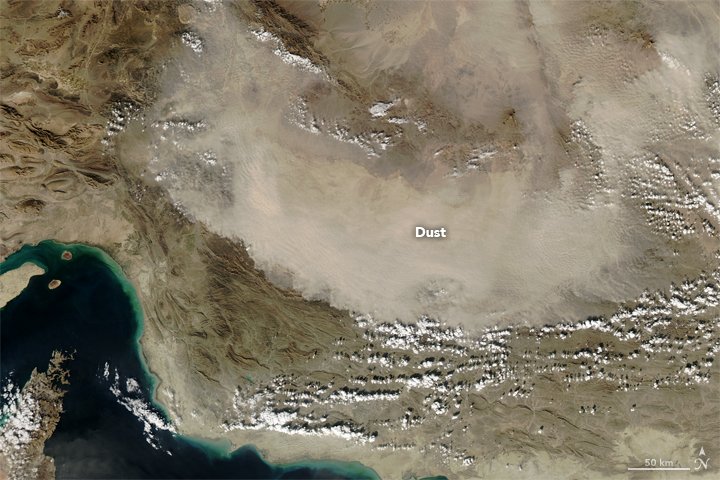[:ja]NASAの地球観測衛星Aquaが2016年12月10日に撮影した、イランの砂嵐です。

世界気象機関WMOによると、過去15年仇で、中東の砂嵐の強さと頻度が格段に上昇していると報告されています。最も悪影響のあるのはイランとクウェートです。
一つの原因として指摘されているのが、イランを流れる河川の上流国でのダム建設ラッシュです。これにより、イランの河川が細り、枯渇した乾燥した川底の砂が舞い上がり、砂嵐を強力にしていると考えられています。
2015年6月のテヘランの砂嵐の様子はこちらです。

参考文献: Dust Billows Over Iran
ウェブ地球儀で地球俯瞰画像を見る: LiVEARTH
[Earthview Wonders] No.151: Dust Storm in Iran
NASA’s Aqua satellite captured Iran’s severe sand storm on Dec. 10, 2016.

According to WMO (World Meteorological Organization), a significant increase in frequency and the intensity of sand and dust storms has been observed in the Middle East over the past 15 years. The countries of worst effects inflicted are Iran and Kuwait.
One of the possible reasons for this is a race in dam construction in upstream countries. This leads to the disappearance of marshes and drying up of lakes, increasing the intensity and frequency of sand storms.
The sand storm of June 2015 looked like this.

Reference: Dust Billows Over Iran
See earthview photo gallery with web-globe: LiVEARTH[:en][Earthview Wonders] No.151: Dust Storm in Iran
NASA’s Aqua satellite captured Iran’s severe sand storm on Dec. 10, 2016.

According to WMO (World Meteorological Organization), a significant increase in frequency and the intensity of sand and dust storms has been observed in the Middle East over the past 15 years. The countries of worst effects inflicted are Iran and Kuwait.
One of the possible reasons for this is a race in dam construction in upstream countries. This leads to the disappearance of marshes and drying up of lakes, increasing the intensity and frequency of sand storms.
The sand storm of June 2015 looked like this.

Reference: Dust Billows Over Iran
See earthview photo gallery with web-globe: LiVEARTH[:]